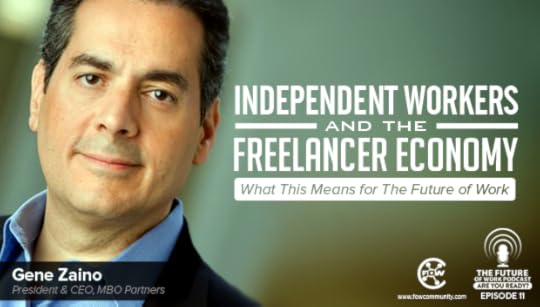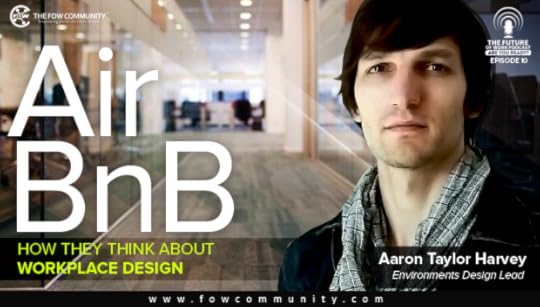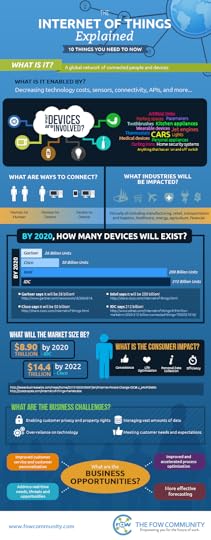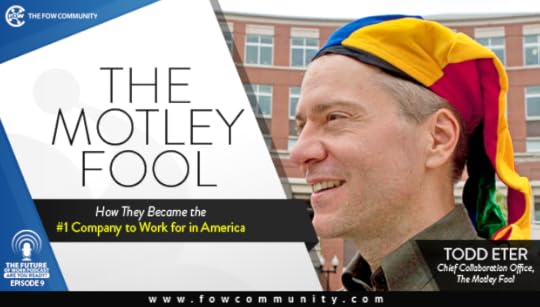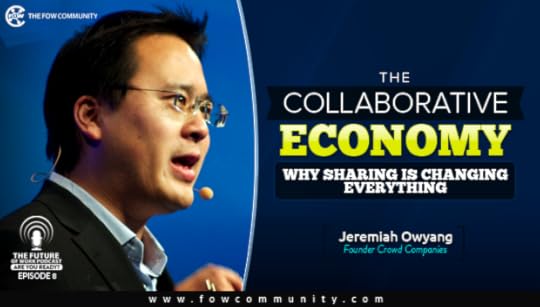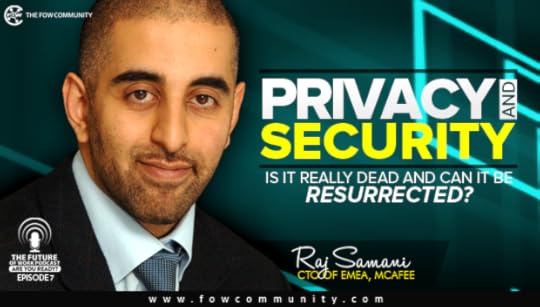Jacob Morgan's Blog, page 29
November 10, 2014
7 Principles of the Future Employee
It’s safe to say that the employee of tomorrow is not the same person as the employee of yesterday. The five trends shaping the future of work helped make sure of that fact. A few weeks ago I also shared another visual called The Evolution of the Employee which compares employees of the past and future. Oftentimes when I speak at conferences or visit with companies they ask me how the way we work is changing and so that prompted me to put together something called the 7 Principles of the Future Employee. The best way to think about this is as the 7 core ways that employees of the future will work. These are details in my latest book on the future of work but a brief summary can be found below.
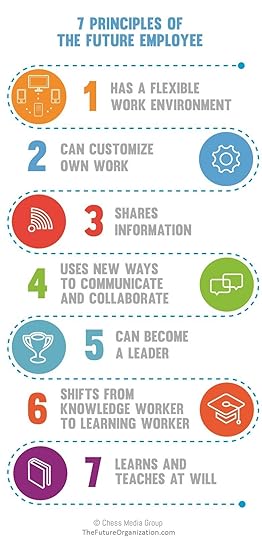
Has a flexible work environment- Employees are no longer bound to the office where they are forced to commute an hour each way, sit in a cubicle, and work 9-5. Most employees will become location independent and will be able to work when and where they want as long as they can get access to wifi.
Can customize work- I talk about several ways to customize work in by book. The basic concept here is that being hired in one role for a long-term career is dead. Employees will be able to shape their career paths and choose the projects they work on. “Work” will become more like a “choose your own adventure game” vs “finding your way through the maze.”
Shares information- The mentality of “knowledge is power” meant that employees hoarded information so that nobody else could take credit for their ideas. Unfortunately this doesn’t help anyone. The mentality going forward is all about, “sharing is power.” The employees who share their ideas and information and use collaborative technologies and internal social networks are going to be the ones that succeed and grow their careers.
Uses new ways to communicate and collaborate- Email is no longer the most effective or efficient way to communicate or collaborate. Many emergent technologies such as internal collaboration platforms are going to start to replace email in many situations.
Can become a leaders- For the first time in the history of business, employees have the unique opportunity to become leaders within their organizations by sharing their ideas and feedback in a public and transparent way for their peers, managers, and executives to see. Never before were employees able to build their networks within an organization at scale and get recognized for their contributions, technology has dramatically empowered employees!
Shifts from knowledge worker to learning working- Knowledge is a commodity, to be the smartest person in the room all you need is a smartphone. What is far more valuable than knowledge is the ability to learn new things and apply those leanings to new scenarios and environments. This is what the employee of the future needs to focus on, “learning to learn.”
Learns and teaches at will- The traditional way to learn and teach was largely guided and dictated by organizations who set out training programs, manuals, and set courses. Technology is connected employees and information together anywhere, anytime, and on any device. This means that learning and teaching can happen between employees without official corporate training programs or manuals. Have a question? Tap into the collective intelligence of your company. Want to show someone how to do something? Whip out your smartphone, film it, and upload it to your organizations collaboration platform for your peers to see.
These are the 7 Principles of The Future Employee…this is how work will get done over the next few years and it has already started in many organizations around the world.
 Send to Kindle
Send to KindleThe post 7 Principles of the Future Employee appeared first on .






November 6, 2014
Independent Workers and the Freelancer Economy
Click Here to Subscribe via iTunes
Click Here to Subscribe via RSS Feed (non-iTunes feed)
http://traffic.libsyn.com/futureofworkpodcast/Gene_Zaino_Podcast_Done.mp3
The one stat you need to know
The 4th annual 2014 MBO Partners State of Independence in America workforce study reports a growing headcount of 17.9 million “solopreneur” independent workers – or those who regularly work 15 hours or more per week as independents, with most working more than 35 hours per week. This is up 1.2% from 2013 and 12.5% from the base year of 2011. This growth, which is more than 11 times higher than the 1.1% growth in the overall U.S. labor force during this 4-year period, demonstrates the continued, structural shift toward independent work.
What this episode is about and why you should care
Today, approximately 30 million workers in America are considered to be independent workers, that’s almost 10% of the population and this number is expected to grow quite a bit. Long term and life-time employment is dead so we are seeing businesses and “employees” shift towards a new way of working. This need breed of independent worker values being their own boss, autonomy, and flexibility. A recent study by Oxford Economics found that 83% of executives are actually going to be increasing their investment in the contingent workforce over the next few years. It’s easy to scale, manage, and fill skill gaps when needed. Not to mention it gives people the opportunity to work with top talent and companies from around the world. But what impact will this independent workforce have on how we think about employees and organizations? How will this new type of worker impact the future of work?
In this episode I talked to Gene Zeno, CEO and founder of MBO partners, a leading business platform that helps independent consultants succeed. They offer services that support the freelancers in tax handling, expense, benefit, payment and contract management with direct vendor access into enterprises. We cover quite a bit in this podcast, enjoy!
What you will learn in this episode
What does the freelance economy mean for the businesses? What does it means for us as employees?
What is the state of freelance economy in America and the world
How to define a solopreneur, an independent worker, or a side-giger
What role does government regulation and policy play in the freelancer economy?
How will our traditional idea of employment change?
Is long-term employment realistic?
How are companies changing the way they think about work and are they shifting to more task and project based styles?
What should organizations be thinking about when it comes to the freelancer economy?
Links from the episode MBO partners
 Send to Kindle
Send to KindleThe post Independent Workers and the Freelancer Economy appeared first on .






November 4, 2014
The Five Trends Shaping the Future of Work
If there’s one thing that we can all agree on it’s that the world of work is changing…quickly. The way we have been working over the past few years is NOT how are we are going to be working in the coming years. Perhaps one of the most important underlying factors driving this change is the coming shift around who drives how work gets done. Traditionally executives would set the rules and pass those down to managers who in turn would pass those down to employees. But as Dan Pink aptly put it, “talented people need organizations less than organizations need talented people.” In other words employees are now starting to drive the decisions and conversations around how work gets done, when it gets done, who it gets done with, what technologies are being used to get it done, etc. The next few years are going to bring about dramatic changes. But why now? What are the key trends that are driving this new future of work? There are five of them as seen below, and before exploring anything else around the future of work it’s crucial that we understand these.
New behaviors
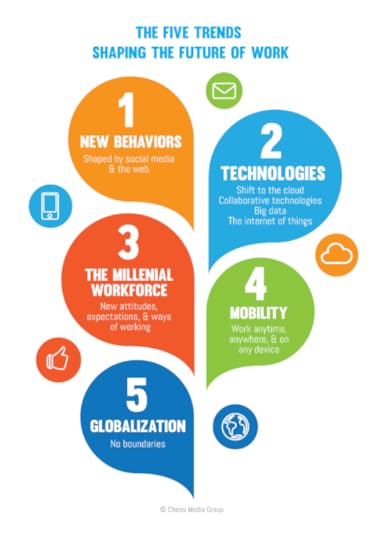
Ten years ago if someone were to tell you that you would have all this information about yourself public for the world to read, see and hear, you would have said they were crazy. Now look at where we are, we are so much more comfortable living more public lives, we build communities, share, communicate, collaborate, access information, and shape our personal experiences. All these new behaviors are cascading over organizations which is forcing them to make changes.
Technologies
Big data, the cloud, the internet of things, robots, automation, video, collaboration platforms, and other technologies are changing the way we work and live. The cloud puts the power of technology in the hands of employees, robots and software are forcing us to rethink the jobs that humans can and should do, big data gives us insight into how we work and how customers transact with use, and collaboration platforms give us the ability to connect our people and information together anywhere, anytime, and on any device.
Millennials in the workplace
By 2020 millennials are expected to make up around 50% of the workforce, by 2025 this number is projected to be 75%. The important thing about millennials isn’t the fact that they might bring new approaches, ideas, values, or styles of working; it’s that there are going to be so many of them. They are by all accounts going to be the largest generation to ever enter the workforce. This is a generation of employees with technological fluency that is willing to live at home longer until they find a company that they truly want to work for. In other words, organizations must shift from creating an environment where they assume that people NEED to work there to one where people WANT to work there.
Mobility
It’s absolutely fascinating that living in the Bay Area, I can access virtually the same type of information that someone else can living in a remote rice patty field in China. Today where you are is starting to matter much less when it comes to being able to do your job. As long as you can connect to the internet, chances are you can access the same people and information as if you were working in an office building. We are connected anywhere and everywhere we go whether it be 35,000 in the air or in a home office.
Globalization
This is essentially the ability for organizations to work in a world where boundaries do not exist. The world is becoming just like one big city. The language you speak, the currency you transact in, and where you are physically located are starting to matter less and less. You can work in San Francisco yet have clients in Beijng or Melbourne; the same goes for employees. Boundaries to working with anyone and anywhere are being crushed and this trend will only continue.
What do you do now and where do we go from here? Well, you’re just going to have to keep reading this blog to find out!
 Send to Kindle
Send to KindleThe post The Five Trends Shaping the Future of Work appeared first on .






November 3, 2014
Work As We Know it is Dead
I don’t mean that work doesn’t exist and that we should all just drop what we are doing and quit our jobs, in fact, far from it. When I say “work as we know it is dead,” I’m specifically referring to the assumption that employees are cogs, managers are slave-drivers, and work is drudgery- these by the way, are all synonyms you can find in the dictionary. This mentality that we are all cogs working for a slave-driver as we go about our daily drudgery is exactly what I mean when I say “work as we know it is dead.”
This idea has been a bit of a recurring theme in my latest book on The Future of Work, and is something that I am quite passionate about. I wanted to share a short ebook or manifesto on this topic which summarizes this concept. It’s completely free for you to read, download, and share. Enjoy
 Send to Kindle
Send to KindleThe post Work As We Know it is Dead appeared first on .






October 31, 2014
How AirBnB Creates Amazing Workspaces
Click Here to Subscribe via iTunes
Click Here to Subscribe via RSS Feed (non-iTunes feed)
http://traffic.libsyn.com/futureofworkpodcast/aron_taylor_harvey_podcast_DONE.mp3
What this episode is about and why you should care
With the first tech boom in the late 90’s there was a mentality among startups that sent a clear message – We are never going to work in cubicles. Designers of workspaces followed that mentality and big open spaces emerged, ideally providing collaboration and communication between employees and helping “flatten” out their organizations. But, people didn’t just need collaboration, they needed focus, engagement, and an environment that represents who they are and how they want to work.
Culture, workflow, the physical environment, and engagement all became essential for workplace designers to focus on. This emphasis on the workspace creates an employee experience which in turn helps attract and retain top talent; a business imperative for any organization.
To explore this in more detail my guest for this week was Aaron Taylor Harvey who is the environments design lead at Air BnB who is responsible for creating their workspaces. We explored themes such as the impact that workspaces have on engagement and culture and how Aaron and AirBnB go about creating amazing workspaces for employees.
What you will learn in this episode
What impact does the physical space have on how the employees work?
How can you get people working intensely, collaboratively without creating walls?
What are the cultural symbols of privacy?
What are the components that people need for their work?
What is the office of Air BnB in Portland like?
What does an ideal office space look like and how do you create one?
Do cubicles have a place in the modern day organization?
What is it like to work at Air BnB?
Examples of different types of office setups and how they reflect a unique culture
The importance of creating a work experience
Links from the episode:
 Send to Kindle
Send to KindleThe post How AirBnB Creates Amazing Workspaces appeared first on .






October 29, 2014
Ten Things You Need to Know About the Internet of Things
The internet of things is a big topic that consumers and companies alike are exploring. This idea of connecting billions of devices to each other and to ourselves is a fascinating thing to think about. Imagine your alarm clock telling your coffee maker to when to brew our favorite roast or your outlook calendar syncing with your car to notify you when you need to head out, what the traffic will be like, and what route to take. What about a jet engine that self diagnosis itself and sends a report to an engineer. We already see this connectivity with wearable fitness devices that connect to our scales or smartphones that connect to our home appliances and light bulbs. This is just the beginning!
I wrote about this in much more depth over on my Forbes column which I definitely recommend you read.
Over at the FOWCommunity (where we explore all things related to the future of work) we decided to put together a little infographic to help add some clarity to this rapidly changing and growing area. Hope you find it to be a valuable and informative resource, fee free to share it around!
 Send to Kindle
Send to KindleThe post Ten Things You Need to Know About the Internet of Things appeared first on .






October 23, 2014
How The Motley Fool Became the #1 Company in America to Work For
Click Here to Subscribe via iTunes
Click Here to Subscribe via RSS Feed (non-iTunes feed)
http://traffic.libsyn.com/futureofworkpodcast/Podcast_Todd_Done.mp3
The one stat you need to know
“According to a new report by the Conference Board, the New York-based nonprofit research group, some 54.6% liked their physical environment in 1987 versus 56.4% today, and 54.7% liked their equipment in 1987, compared to less than a percentage point more today, 55.2%. The report’s authors speculate that the increase in telecommuting offers a partial explanation, as people prefer working at home to being in the office and employers are responding by rethinking and improving equipment and workspaces.” – Forbes by Susan Adams
What this episode is about and why you should care
Imagine if you walked into a financial firm looking for investment advice, and suddenly, you see this person, wearing shorts coming to greet you. Would you be interested in working with him/her? I’m sure a lot of people would find this a bit shocking. Financial firms are seen as conservative, buttoned up, and suit-and-tie organizations.
On the other end of the spectrum, as an employee, have you ever thought of going to an office whenever you just feel like it with your casual clothes on, doing on-site yoga or meditation, getting a haircut or a massage, or playing with Nerf guns? Many people would think that these are silly things that can’t really make an impact on employee engagement or culture.
To learn more about how an organization is challenging convention and traditional stereotypes of having a conservative workplace I talked to Todd Etter, Chief Collaboration Officer of The Motley Fool. The Motley Fool is a web-based company designed to help people manage their financial life. In 2014 The Motley Fool was ranked by Glass Door as the #1 company in America to work for based on their size.
What you will learn in this episode
In depth look at The Motley Fool’s core values – collaborative, innovative, fun, honest, competitive, and motley.
How these core values are ingrained in how employees work.
What it’s like to work at The Motley Fool
Perks and incentives working in a very unique organization. How these benefits were created.
Schedules of employees – Do they have to come to the office, or can they work anytime, anywhere?
How the company uses games for business activities like meetings and annual reports.
Privacy and security – How open is The Motley Fool with information within the organization?
Tangible results of working “the Motley way” - Are these things meaningful or silly?
What can medium-sized or larger organizations learn from what The Motley Fool is doing?
Advice for other companies wanting to change their corporate culture, or to be able to do what The Motley Fool is doing.
Role of management in creating this kind of desirable place to work
How Motley Fool balances and structures its organizational chart.
Overview of two Motley Fool’s programs – Pick Your Own Device (PYOD), and internal recognition and rewards program, You Earned It.
Turnover or retention rate in the company. Are people more productive?
Advice for managers, employees, and companies on what they should be doing, and what they should be thinking about.
Links from the episode:
 Send to Kindle
Send to KindleThe post How The Motley Fool Became the #1 Company in America to Work For appeared first on .






October 16, 2014
Why The Sharing Economy is Changing Everything
Click Here to Subscribe via iTunes
Click Here to Subscribe via RSS Feed (non-iTunes feed)
http://traffic.libsyn.com/futureofworkpodcast/Jeremiah_podcast.mp3
The one stat you need to know
Forbes estimates “The revenue flowing through the share economy directly into people’s wallets will surpass $3.5 billion this year, with growth exceeding 25%. At that rate, peer-to-peer sharing is moving from an income boost in a stagnant wage market into a disruptive economic force.” – Forbes Jan 2013
What this episode is about and why you should care
The collaborative economy is an economic system based on people sharing their resources including goods to services. The system takes advantage of information technology that enables the sharing of products and services rather than individual ownership. For example instead of buying a car you can user Uber or Lyft to get around. Instead of going to a box retailer to get something you an go to Etsy and get something directly from individuals. Need a wedding dress? No problem you can get that at Rent the Runway. What about a place to stay? No need to go to a hotel when consumers just like you and me are offering up their own places for people to stay in via Air BnB. The collaborative economy is allowing individuals to connect with each other while bypassing the traditional businesses. Clearly this is a major disruption that is impacting the economy, organizations, and individuals as well. For us to fully understand what the collaborative economy is, I talked to Jeremiah Owyang from Crowd Companies.
What you will learn in this episode
The definition of the collaborative economy.
The Importance of the collaborative economy and why it is so distruptive.
What’s going to happen when robots come into play in the collaborative economy
Is the collaborative economy a short term fad that’s eventually going to be replaced? Or is this going to be a long term sustainable thing that’s going to be impacting the world?
Examples of companies in the collaborative economy.
How different generations are taking advantage of the collaborative economy.
What are the driving forces behind the collaborative economy?
The impacts of the collaborative economy on businesses.
The first companies or leading organizations that started the collaborative economy movement.
Is renting the same as the collaborative economy? What’s the distinction between the two?
The impact of collaborative economy on the government – impacts on safety, security, liability, regulation, and taxation.
What are the negative effects or problems that may arise as a result of the collaborative economy?
What is the future of the collaborative economy?
Links from the episode:
 Send to Kindle
Send to KindleThe post Why The Sharing Economy is Changing Everything appeared first on .






October 15, 2014
The Single Greatest Cause Of Employee Disengagement
We all lead “double lives.” We have our personal lives where we can: control the technologies and devices we want to use, build and shape communities, share and collaborate with who we want where we want, easily access information, take out loans on a house and make purchases, and have the freedom and flexibility to live how we want. Then we have our professional lives where we: commute an hour each way, use company sanctioned technology, sit in cubicles, get 200+ emails a day, are not able to effectively communicate and collaborate, operate under a command and control hierarchy, feel like a cog, and need to get approvals for buying a $100 office chair.
Should we be shocked that synonyms for employee include “cog” or “slave ?” Or that synonyms for managers include “slave-driver” and “zookeeper.” My favorite synonyms are for “work” which include “drudgery” and “daily-grind.” We spend more hours working than doing anything else in our lives so in 2014 and beyond it’s completely unacceptable that we spend the majority of our time on this earth doing things that are beyond our control.
It’s no wonder that the majority of employees around the world don’t like their jobs and there is one key reason for that. Work practices, attitudes, values, strategies, technologies, and ways of working are evolving and changing at a rapid pace, whereas organizations remain stagnant when it comes to adapting to these changes.
We live in 2014 and work in 1970. This gap is what causes employee disengagement.
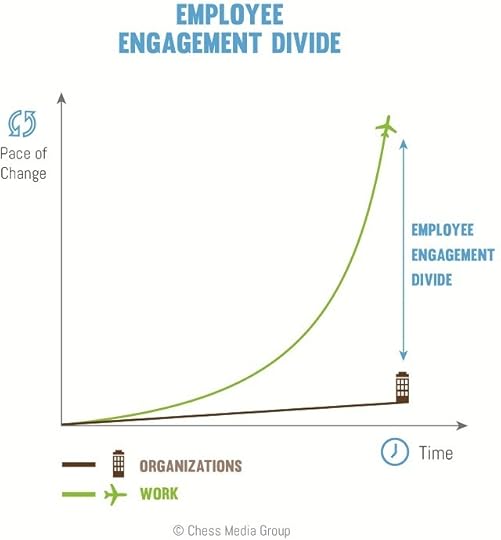
Many companies still operate as though employees are expendable, assume that managers are powerful leaders who should control all the information and remain stoic, and that there needs to be a bureaucratic “pecking order” to how things get done.
When it comes to the future of work, organizations must focus on closing this gap. Consider an organization such as gaming company Valve which has completely gotten rid of managers altogether in favor of an approach where employees pick what they want to do, who they do it with, and when they do it. Or how about Whirlpool which recently took a unique approach to leadership by stating that everyone at the company should be a leader and created four categories that every employee in the organization can fit into (leaders self, leading others, leading function, and leading enterprise). Then we have organizations like Netflix NFLX which doesn’t have a vacation policy for employees and allows their team members to make their own purchases without having to get approval for everything they need.
Other companies like Unilever are focusing on workplace flexibility; Unilever seeks to have 30% of their 175,000 employee be location independent by 2015. Perhaps one of my favorite examples comes from 1,000+ person company in Canada called Tangerine. Their CEO Peter Aceto has taken a completely unconventional approach to leadership to the point where he actually encourages employees to tell him about their frustrations or what they might not like about working at the company. Peter has also done a tremendous job of embracing vulnerability in the workplace and shedding the traditional robotic manager approach.
We need more companies in the world that acknowledge this gap between how we work how we live. Companies that focus on closing this gap are going to be the ones that attract and retain top talent, build better leaders, and thrive in the new world of work. If your organization doesn’t think about and plan for the future of work, then your organization has no future!
 Send to Kindle
Send to KindleThe post The Single Greatest Cause Of Employee Disengagement appeared first on .






October 9, 2014
Is “Privacy and Security” Really Dead?
Click Here to Subscribe via iTunes
Click Here to Subscribe via RSS Feed (non-iTunes feed)
http://traffic.libsyn.com/futureofworkpodcast/raj-samani-podcast.mp3
The one stat you need to know
86% of internet users have tried to use the internet in ways to minimize the visibility of their digital footprints. 55% of internet users have taken steps to hide from specific people or organizations. – Pew Research
What this episode is about and why you should care
A few weeks ago on Forbes, I wrote an article called, Privacy Is Completely And Utterly Dead, And We Killed It, as a follow up to that article I wanted to do a podcast. To me, it feels like we’re in a place where privacy and security is not only dead but we, as people, are kind of helping facilitate the death of privacy and security.
This whole series on privacy and security was inspired by the movie “Terms and Conditions may Apply” which provides a fascinating look at how organizations such as Google, Amazon, Twitter, or Facebook are collecting, and using information that users may or may not be aware that they are giving away. It got me thinking, “Is privacy and security dead?” We’re signing away our information every time we use our iPhone, iTunes, Google, or Facebook yet we all keep doing it.
To help discuss this topic, I decided to talk to Raj Samani, the EMEA Chief Technical Officer at McAfee and member of the Advisory Group on Internet Security at the EUROPOL CyberCrime Centre.
What you will learn in this episode
How to make your personal data more valuable?
Issues and problems with regards to personal privacy and security.
Should people care about giving personal information when buying goods or services online?
3 key components required for the future of privacy or better decisions to be made.
The impact of privacy and data for consumers and individuals.
What happens if people don’t value their personal data?
What people should do to be conscientious about their personal privacy and security?
The concept behind digital tattoo.
Privacy and security within organization, and the big challenge on CIOs and CTOs are being faced with.
What can CTOs or CIOs do to deal with organizations that are struggling with organizational privacy and security?
The impact cloud is having on privacy and security – does it make sense for organizations to shift to the cloud?
What should organizations do on privacy and security?
Links from the episode:
 Send to Kindle
Send to KindleThe post Is “Privacy and Security” Really Dead? appeared first on The Future Workplace.







